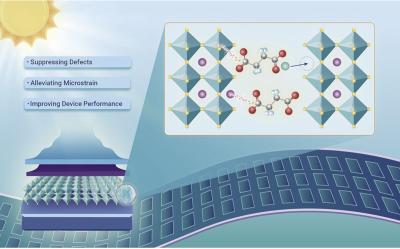Perovskite-Info weekly newsletter
Published: Tue, 09/13/22
The Perovskite-Info newsletter (September 14, 2022)
Cannot read this? View it online here
New carbazole-based hole transporting materials to improve the stability of perovskite solar cells
Scientists from Kaunas University of Technology and Vilnius University in Lithuania and University of Colorado in the U.S have proposed a method for increasing the stability and performance of perovskite solar cells. The team synthesized a new class of carbazole-based cross-linkable materials, which are resistant to various environmental effects, including strong solvents used in the production of solar cells.
When applied as hole transporting layers, the new materials helped achieve the 16.9% efficiency of the inverted-architecture perovskite cells at the first attempt. It is expected to reach higher efficiency upon optimization.
Researchers explore potential-induced degradation in perovskite/silicon tandem modules
Scientists from King Abdullah University of Science and Technology (KAUST) and Solar Energy Research Institute of Singapore (SERIS) have examined the potential-induced degradation (PID) susceptibility of perovskite-silicon tandem devices fabricated in their lab. They exposed tandem cell devices to PID stress and found that they lost as much as 50% of their initial performance after just one day. This led the team to assess that more work needs to be done on the issue before perovskites can be commercialized and deployed at scale.
Research on perovskite solar cells' stability challenges has largely focused on the material’s sensitivity to moisture, high temperatures, and other environmental conditions. Potential-induced degradation (PID), caused by currents leaking from the cell and driving various damaging mechanisms, has long been a threat to performance in silicon PV modules, but has so far been much less explored in emerging PV technologies such as perovskite.
Researchers improve flexible perovskite solar cells with succinate additive
A team of researchers from China's Tsinghua University, National Center for Nanoscience and Technology and Switzerland's Institute of Computational Physics (ICP) of the ZHAW School of Engineering have proposed a strategy to reduce defects and microstrains in perovskite films through multifunctional additives, achieving a record PCE of 23.6% for single-junction flexible perovskite solar cells (FPSCs).

Flexible perovskite solar cells (FPSCs) prepared on flexible substrates, which possess excellent flexibility and a high power-to-weight ratio, hold promise as a power source for wearable electronic devices, aerospace, and building integrated photovoltaics (BIPVs). Further improving the power conversion efficiency (PCE) and bending resistance of flexible devices is key to promoting their practical application.
Researchers report that lattice distortion of perovskite QDs induces coherent quantum beating
A research team, led by Prof. Wu Kaifeng from the Dalian Institute of Chemical Physics (DICP) of the Chinese Academy of Sciences (CAS), in collaboration with Dr. Peter C. Sercel from the Center for Hybrid Organic Inorganic Semiconductors for Energy, recently reported the utilization of lattice distortion in lead halide perovskite quantum dots (QDs) to control their exciton fine structure.
Shape or crystal anisotropy in QDs results in energy splitting of their optically bright excitons (bound electron-hole pairs), known as fine structure splitting (FSS). For example, the excitons' FSS can be exploited for coherent control of quantum states for quantum computing, or for polarization-entangled photon-pairs in quantum optics, although for the latter it is important to suppress the magnitude of splitting. Studying FSS usually requires single or just a few QDs at liquid-helium temperature, due to its sensitivity to QD size and shape. Measuring FSS at an ensemble-level, much less controlling it, seems impossible unless all the dots are made to be nearly identical.
Metalgrass LTD
9 Har Tsin St.
Kfar Sava Hasharon 4430809
ISRAEL
Unsubscribe | Change Subscriber Options




